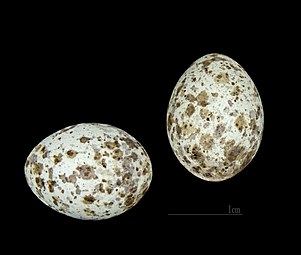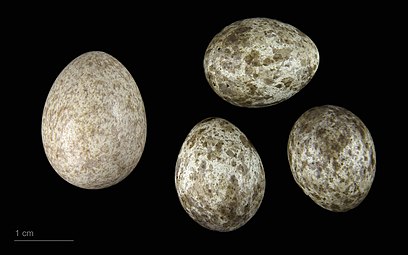Common reed warbler
| Common reed warbler | |
|---|---|

| |
| Song recorded in Surrey, England | |
| Scientific classification | |
| Domain: | Eukaryota |
| Kingdom: | Animalia |
| Phylum: | Chordata |
| Class: | Aves |
| Order: | Passeriformes |
| Family: | Acrocephalidae |
| Genus: | Acrocephalus |
| Species: | A. scirpaceus
|
| Binomial name | |
| Acrocephalus scirpaceus (Hermann, 1804)
| |
| Subspecies | |
|
See text | |

| |
| Distribution
Breeding range
Resident year-round
Passage
Non-breeding range
| |
The common reed warbler (Acrocephalus scirpaceus) is an
. It is also a resident species over large parts of Africa.Taxonomy
The common reed warbler was
Ten subspecies are recognised:[4]
- A. s. scirpaceus (Hermann, 1804) – breeds in Europe to west Russia, Ukraine and west Turkey, northwest Africa, winters in west, central Africa
- A. s. fuscus (Hemprich & Ehrenberg, 1833) – breeds in north Egypt and central Turkey through the Middle East to southeast European Russia, north Iran, Kazakhstan and northwest China; winters in eastern and southern Africa
- A. s. avicenniae Ash, Pearson, DJ, Nikolaus & Colston, 1989 – coasts of the Red Sea[6][7]
- A. s. ammon Hering, Winkler & Steinheimer, 2016 – Oases along the Libya-Egypt border region[8]
- A. s. ambiguus (Brehm, AE, 1857) – Iberian Peninsula and northwest Africa
- A. s. minor Lynes, 1923 – Sahel region from Senegal to west-central Sudan (Darfur)
- A. s. cinnamomeus Reichenow, 1908 – west Ethiopia and south Somalia south through South Sudan, Uganda, Kenya, Zambia and Mozambique; patchy distribution in west Africa from south Cameroon to possibly Niger and Mali
- A. s. suahelicus Grote, 1926 – east Tanzania to east Mozambique and eastern South Africa
- A. s. hallae White, CMN, 1960 – southwest Angola to southwest Zambia and south to western South Africa
- A. s. baeticatus (Vieillot, 1817) – north Botswana and Zimbabwe to southern South Africa[9]
An older scientific name for the reed warbler was Acrocephalus streperus (Vieill.).[10]
The mostly resident Iberian and African subspecies are sometimes treated as a separate species, the African reed warbler (Acrocephalus baeticatus).[4][11][12]
Description
This is a medium-sized warbler, 13 cm (5.1 in) in length with a wing-span of 17–21 cm (6.7–8.3 in).[13] The adult has an unstreaked brown back and buff underparts. The forehead is flattened, and the bill is strong and pointed. The sexes are identical, as with most warblers, but young birds are richer buff below. The common reed warbler looks similar to the great reed warbler, but the great reed warbler is larger in size and has a stronger supercilium.
The song is a slow, chattering jit-jit-jit with typically acrocephaline whistles and mimicry added.
Distribution and habitat
This small passerine bird is a species found almost exclusively in reed beds, usually with some bushes.
Behaviour and ecology
Food and feeding
Like most warblers, it is
Breeding
The males return to the breeding grounds two or three weeks before the females.
The common reed warbler is one of the species that are brood parasitised by the common cuckoo.[18]
Gallery
-
Placement of nest
-
View of nest with clutch
-
Reed warbler eggs
-
Cuculus canorus canorus egg in a clutch of Acrocephalus scirpaceus -MHNT
-
Common cuckoo chick fed by reed warbler adult
References
- . Retrieved 25 January 2020.
- ^ Hermann, Johann (1804). Observationes zoologicae quibus novae complures, aliaeque animalium species describuntur et illustrantur (in Latin). Argentorati [Strasbourg]: Amandum Koenig. pp. 202–203.
- ^ Mayr, Ernst; Cottrell, G. William, eds. (1986). Check-list of Birds of the World. Vol. 11. Cambridge, Massachusetts: Museum of Comparative Zoology. p. 62.
- ^ Rasmussen, Pamela, eds. (January 2022). "Bushtits, leaf warblers, reed warblers". IOC World Bird List Version 12.1. International Ornithologists' Union. Retrieved 12 June 2022.
- ISBN 978-1-4081-2501-4.
- ^ Ash, J.S.; Pearson, D.J.; Nikolaus, G.; Colston, P.R. (1989). "The mangrove reed warblers of the Red Sea and Gulf of Aden coasts, with description of a new subspecies of the African Reed Warbler Acrocephalus baeticatus". Bulletin of the British Ornithologists' Club. 109: 36–43.
- S2CID 155777594.
- ^ Hering, J.; Winkler, H.; Steinheimer, F.D. (2016). "A new subspecies of Eurasian Reed Warbler Acrocephalus scirpaceus in Egypt". Bulletin of the British Ornithologists' Club. 136: 101–128.
- ^ Vieillot, Louis Pierre (1817). Nouveau dictionnaire d'histoire naturelle, appliquée aux arts, à l'agriculture, à l'économie rurale et domestique, à la médecine, etc (in French). Vol. 11 (Nouvelle édition ed.). Paris: Deterville. p. 195.
- .
- S2CID 241415727. Retrieved 26 August 2022.
- PMID 27233439.
- ^ Cramp 1992, p. 193.
- ^ Cramp 1992, pp. 198–201.
- ^ Cramp 1992, p. 203.
- ^ Cramp 1992, p. 201.
- ^ Cramp 1992, pp. 208–209.
- S2CID 56303051.
Sources
- ISBN 978-0-19-857509-2.
External links
- Eurasian reed warbler videos, photos & sounds on the Internet Bird Collection
- Avibase[permanent dead link]
- Ageing and sexing (PDF; 2.3 MB) by Javier Blasco-Zumeta & Gerd-Michael Heinze Archived 2016-11-08 at the Wayback Machine
Bibliography
- Kishkinev, D., Chernetsov, N., Pakhomov, A., Heyers, D., and Mouritsen, H. (2015). Eurasian reed warblers compensate for virtual magnetic displacement. Curr. Biol. 25, R822–R824






